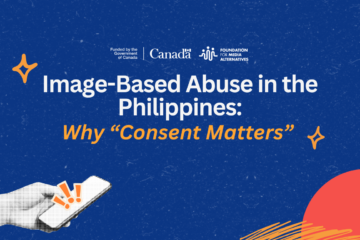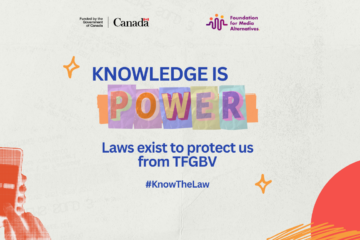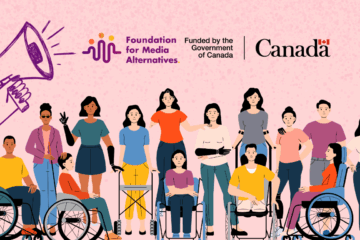Midyear Report: Online Gender-based Violence in the Philippines (January 1-June 30, 2022)
The internet is one of the most powerful and enabling platforms for opportunity, sharing ideas and building community, but women and other vulnerable groups are too often threatened, silenced and censored because of having courage to speak out. Since 2012, the Foundation for Media Alternatives has been monitoring and documenting cases of online gender-based violence in the Philippines through the Take Back the Tech! mapping platform. Over the years, FMA has observed a growing incidence of gender-based violence and how it has taken on new forms, occurring in the context of modern and digital society. From 2012 up to June 30, 2022, FMA has mapped 628 cases of online gender-based violence in the Philippines, mostly sourced from media reports.
In the first six (6) months of 2022, new figures were recorded in an online reporting platform with thirty (30) media-sourced reports of online gender-based violence. Most of the mapped reports happened in the National Capital Region (10 reports), Visayas Region (7 reports), Central and South Luzon (7 reports), Mindanao Region (5 reports) and one Filipino case documented in Singapore.
Survivors aged 30 years old and below are more likely to experience online gender-based violence (47%) and majority reported that they suffered online harassment and abuse in a form of taking intimate photos, videos and other private information, inciting violent remarks, abusive comments, online sexual exploitation and abuse of children, non-consensual distribution, and other forms of technology-facilitated different actors.
A survivor’s case may fall under different categories of violations, types of harms and strategies
Online gender-based violence can have serious consequences, ranging from psychological distress and negative health impacts to the survivors. Most of them have suffered emotional and sexual harms, on top of having their reputations damaged for disclosing their cases. These harms were aggravated by the lack of support they receive, which often includes discouragement to socialize and get involved on both online and offline spheres. Women also confront the terms that they have lost their privacy now that their personal and sensitive information were leaked online, redistributed and used against them.
Violations occur in different platforms and these were perpetrated through mobile phones, Meta’s products and services like Facebook and Messenger, followed by video, webcams, laptop and even porn sites.
Majority of the survivors have sought assistance from the law enforcement authority and their cases were investigated and have been brought into trial. Some survivors sought help from State offices for psychosocial intervention.
Other strategies include reporting abuse to the platform, leaving and/or changing the platform, blocking the aggressor on the said platform or device, and having a dialogue or confrontation with the offender.
The Offenders
The offenders have opened the floodgates for new forms of abuse and harassment against women and other vulnerable groups. These offenders are mostly men whom the survivor knew, reflecting the skewed power relations between men and women. For instance, a survivor was hurt and allegedly threatened by his partner to expose the private photos and videos if she would not give in to his requests. In online sexual exploitation of children, children are sexually abused by the offenders (mostly by their parents and relatives) who then stream, spread or sell images or videos of the exploitation online to a larger group of offenders from anywhere in the world. Other vulnerable groups like members of LGBTIQ+ community are not spared from these malicious acts as well. An LGBT rights activist was holding her father’s wake when she received a threatening and homophobic text message. A male migrant worker bought a spy camera online to film his female co-tenant while removing its clothes and taking a shower. He then used the video clips to threaten the woman when she avoided him.
It is even more disturbing to think that the majority of the reported cases are committed by people close to the survivor.
The Philippine government has even pulled off a legal harassment against the Filipino female journalist and has now reached a dangerous and alarming stage for press freedom and safety and security of media practitioners.
Support to Online Gender-based Violence survivors
Women have the right to safety and protection at all times and the Philippines has many mechanisms in place to protect them.
Government agencies such as the Philippine Commission on Women (PCW) have published hotlines where women can report cases of abuse. These include numbers of the law enforcements, the Commission on Human Rights, the Public Attorney’s Office, as well as the telephone numbers of VAW service providers.
The barangays have VAW desks where survivors in the community can report domestic cases and request for the issuance of a protection order.
There are also places that provide temporary shelter for survivors which are run by both government and non-government organizations, where survivors can go if necessary.
Role of technology to create a safe space
While technology was used to perpetrate the abuse, technology can serve as a lifeline for vulnerable groups at the same time. FMA has seen young women go on social media to relate their experiences of harassment and abuse. Some hashtags addressing the issue of harassment and slut-shaming online have trended online as safe spaces where young women can air their grievances, report inappropriate behavior, and demand accountability.
The Lunas Collective, a volunteer-powered helpline in the Philippines, provides support for survivors of gender-based violence and violence against women, and people who may have concerns about family planning.
Some organizations have taken to social media or created online channels and forums to provide women the necessary information they need, including where they can reach out for assistance. This is the case for Bantay Bastos, a Facebook page with ten thousand members who are committed to surfacing, tracking down, and reporting exploitative accounts on Facebook, Twitter and Telegram where child porn peddlers allegedly proliferate. Another one is End Rape Culture PH, who, with eighteen thousand followers on Facebook, came up with an idea of shedding light on the ways our culture normalizes rape and violence towards women and other vulnerable groups.
Currently, internet penetration in the Philippines is reported to be at 68% of the total population of 108.8 million. This means that there are still segments of the population, including women, that are yet to access the internet.#



0 Comments